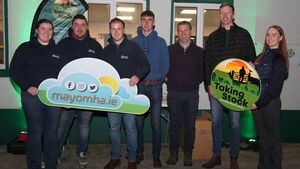Mayo farmers get a chance to 'take stock'

Pictured at the 'Taking Stock' event at Balla Mart were, from left: Aoife Gibbons, Mayo Macra na Feirme Chairperson; James McDonnell, Castlebar Macra; Daniel Conway, Mayo Macra Secretary; Conor O'Rourke, Mayo Macra PRO and Claremorris Macra Chairperson; Michael Rowland, Mayo North East LEADER Parnership; Patrick McCormack, Department of Agriculture; Anna Cunningham, Mayo Mental Health Association's Student Mental Health Promotion Officer). Picture: Trish Forde
There was a strong turnout at Balla Mart recently as farmers from across the region gathered for an event called ‘Taking Stock’.
One of the purposes of the event was to showcase the wide range of grant-aided equipment available through the Targeted Agricultural Modernisation Scheme (TAMS). The evening included hands-on demonstrations, equipment displays, and expert guidance on how to access funding.
Shane O’Haire, dry stock advisor with Teagasc, discussed a range of livestock handling and farm safety equipment and highlighted the 60% grant rate available on many of the items shown.
The TAMS scheme is divided into 10 subsections, with farm safety forming a key focus of the event. Among the more affordable items on display was a sheep weighing scale, clearly labelled with its price and the grant aid available. Mr O’Haire pointed to a sheep wing crate, noting that €545 was available in grant aid for that piece alone.
Out in front of the crowd stood a selection of livestock-handling tools: a leg hoist designed to safely lift a cow’s leg for treatment, and a cattle head scoop for secure handling during dosing or inspection.
“All these products are really about making the farm more efficient - and safer,” Mr O’Haire said. “We all know labour is scarce these days. A lot of work is done solo now, so equipment like this is essential for working safely and effectively on your own.”
Mr O’Haire also introduced sheep hurdles, currently grant-aided at €22 per metre, and a Sheep Handling Race. He explained the difference between the basic and more advanced mobile handling units.
“There’s €638 back on this basic one here,” he said, “but a lot of farmers with fragmented land go for the towable unit, which can be brought behind a jeep or car. That’s granted at over €2,300 - very practical if you’re managing sheep across several locations.”
Beyond livestock handling, the event also highlighted other safety-related investments, including calving gates, dehorning crates, and even calving and lambing cameras, all available under the TAMS Farm Safety heading.
Mr O’Haire stressed the importance of upgrading slatted units, which are also funded to the tune of 60%.
“It might be too late to think about it for this winter, but definitely something to be looking at for next spring."
Mr O’Haire pointed out several pieces of farm equipment that were grant-aided under different schemes.
“Whether it’s a gate, a crate, or a bale slicer,” he said with a smile, “there’s probably a grant for it.
“Everything you see here tonight is classed as mobile equipment. So the first thing you do is log into your AgFood account or talk to your farm advisor. You submit the application under the right TAMS heading - in this case, the Farm Safety Capital Investment Scheme. Then it’s a two to three-month wait for approval.”
While he noted that most applications are successful, he urged caution.
“To be sure, the right advice is to wait until you have the approval letter in hand. After that, you can go ahead, make the purchase, and then submit your claim for payment.”
He added that tax compliance is checked at the claim stage and that receipts must be accompanied by geo-tagged photos of the equipment in the farmer’s yard, including serial numbers. Anyone making a claim under TAMS must complete a certified farm safety course. These are run by Teagasc, the FRS, or other approved providers.”
The meeting also heard that farmers risk significant penalties or even partial loss of payments under the Suckler Carbon Efficiency Programme (SCEP) if they fail to meet key targets.
Teagasc advisor Alan Nolan urged farmers to check their compliance without delay, saying many may be caught out by missed measures as the scheme progresses into its third year.
“This is a circular payment scheme and there are specific actions that farmers have to implement each year in order to get their full payment,” Mr Nolan explained. “We’re in Year Three now, but the Department will be looking at calves born between 1st July 2024 and 30th June 2025 for this year’s targets.”
A major stumbling block for many farmers has been the requirement to calve down at least 50% of their reference number annually.
“That’s what’s caught out the most people,” Mr Nolan told the gathering. “Not staying in the Bord Bia Quality Assurance Scheme and not calving down enough cows has been more of a problem than the Eurostar ratings.”
Each farmer was assigned a reference number when the scheme began, based on their historical calving records. That number determines the targets they must meet each year across five actions: AI or stock bull use, replacement strategy, genotyping, calf/cow weighing, and calving surveys. Each action is worth 20% of the total payment.
Speaking about the requirement for calves to be sired by high-index bulls, Mr Nolan said: “80% of calves born in Years One and Two had to come from four or five-star sires. That has increased to 85% this year and will rise again to 90% in Year Five.”
He reminded farmers that even calves being born now would be counted for Year Four, and that any AI or breeding decisions made in the coming weeks would apply to Year Five. He cautioned against buying in-calf heifers unless the sire is known.
“If you don’t know who the bull is, you could find yourself with calves that aren’t eligible. That could cost you your payment.”
Mr Nolan also referred to the recent changes to the Eurostar index system, which may have affected some herds.
“If you had a four or five-star female who dropped to three stars after that, she’s still eligible for the scheme, as long as she stays in your herd.”
The next deadline in the scheme is October 31st when farmers must have 65% of their replacement females genotyped and rated four or five stars.
“That’s up from 50% in the first year,” Mr Nolan said. “ICBF has written to some farmers who are not on track, warning them they may fall short. You might need to buy eligible heifers, which is expensive at the moment.”
He acknowledged the financial pressure many farmers are under and offered a practical solution: “If you’re short two or three animals and you think it’s uneconomical to buy them, you can take the hit. That means a penalty of 20% on that measure, plus another 30%, but you’ll stay in the scheme.”
Mr Nolan strongly encouraged farmers to log into the ICBF website and check their “SCEP eligibility profile”.
On the genotyping measure, he reminded farmers that 70% of their reference number must be genotyped each year and the samples returned before November 20th..
Stock weighing is another requirement, with 80% of calves needing to be weighed - along with the cow - on the same day. It must be done before weaning, Mr Nolan said.
“The ideal time is between five and eight months of age, before they’re on too much meal.”
He also pointed out a clash with the Beef Welfare Scheme, which requires calves to be fed meal for two weeks after weaning.
“That means you need to weigh them at least two weeks before you plan to sell them.”
The final measure under SCEP involves completing surveys about cow docility, milk yield and calf quality.
“They might seem minor, but they’re worth 20% of your payment,” Mr Nolan said. “You won’t get your December payment unless they’re filled out.”
Farmers also have the option to reduce their reference number by 20% each year, which Mr Nolan said could be wise for some.
"If your cow numbers have dropped and you don’t adjust your reference, you might not meet your calving target and that could put you out of the scheme entirely.”
He briefly covered the separate Beef Welfare Scheme, a one-year programme that typically rolls over annually. Under this scheme, farmers must feed meal for four weeks before weaning and two weeks after, and keep receipts. Optional measures include vaccination for pneumonia or clostridial disease, and either faecal or forage testing.





